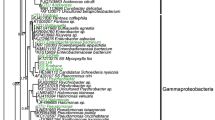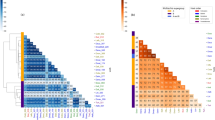Abstract
Whiteflies contain primary prokaryotic endosymbionts located within specialized host cells. This endosymbiotic association is the result of a single infection of the host followed by vertical transmission of the endosymbiont to the progeny. Whiteflies may also be associated with other bacteria called secondary (S-) endosymbionts. The nucleotide sequence of the 16S–23S ribosomal DNA from S-endosymbionts of 13 whitefly species was determined. A phylogenetic analysis of these sequences indicated their grouping into two major clusters, one consisting of two S-endosymbionts related to previously described T-type endosymbionts. The second cluster contained the 16S–23S rDNA sequence of the type strain of Arsenophonus nasoniae as well as sequences of S-endosymbionts from 11 whitefly species. This Arsenophonus cluster contained four S-endosymbionts with intervening sequences of 70–184 nucleotides in their 23S rDNAs. The phylogenetic tree of the Arsenophonus cluster differed greatly from the phylogenetic tree of the primary endosymbionts. These results suggest that, unlike the primary endosymbiont, Arsenophonus may infect whiteflies multiple times and may also be horizontally transmitted.
Similar content being viewed by others
Author information
Authors and Affiliations
Rights and permissions
About this article
Cite this article
Thao, ., Baumann, . Evidence for Multiple Acquisition of Arsenophonus by Whitefly Species (Sternorrhyncha: Aleyrodidae). Curr Microbiol 48, 140–144 (2004). https://doi.org/10.1007/s00284-003-4157-7
Issue Date:
DOI: https://doi.org/10.1007/s00284-003-4157-7




